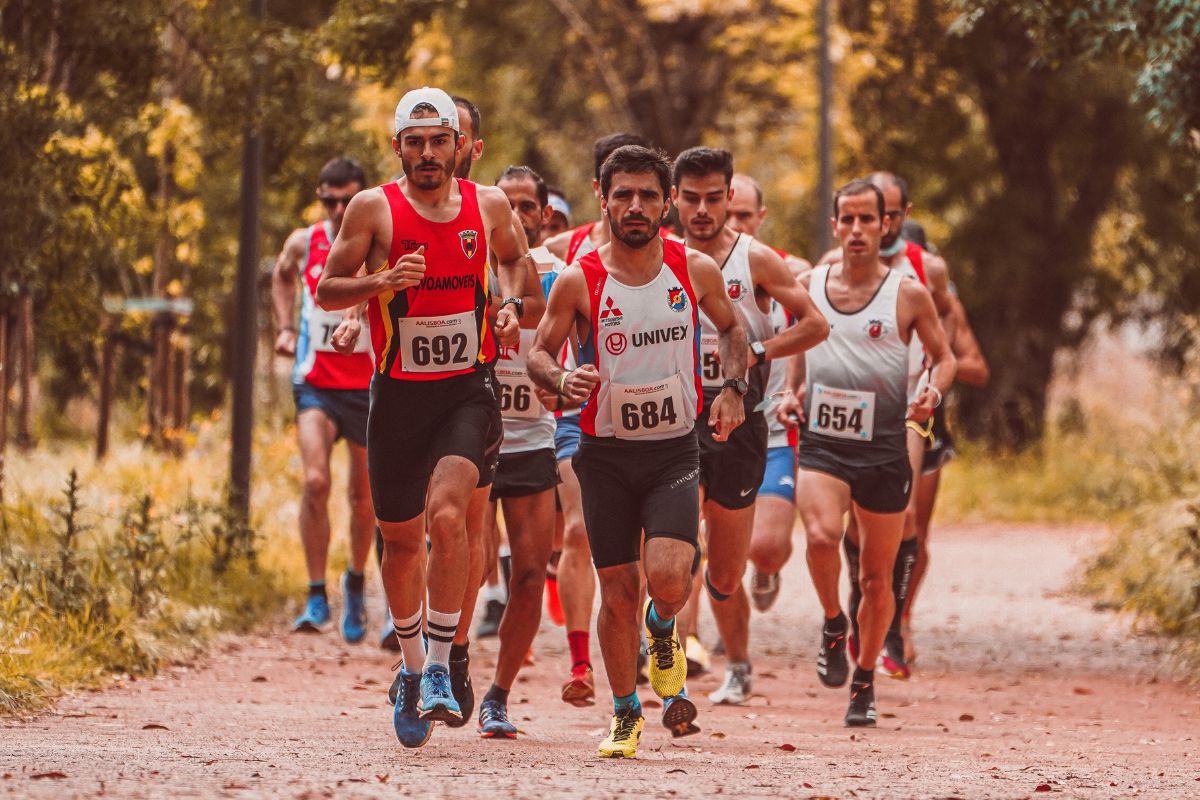Simply taking part and completing a half marathon or 13.1 miles is a great achievement. Designed to challenge your running ability, half-marathons require dedication, proper training, and effective recovery.

Therefore, completing a half marathon in 2 hours or less is an even bigger achievement.
While a sub-2-hour half marathon might not seem possible yet, you’ll be pleased to hear that it’s an easily achievable goal if you prepare correctly.
By following the right steps, sticking to your training plan, performing the right types of training, and pacing yourself, you’ll find yourself easily completing the half marathon distance in 2 hours or less.
Today, to help you achieve your goal, we’re going to show you everything it takes to run a half marathon in under two hours.
If you want to learn how to increase your speed and run the half marathon as fast as you possibly can, be sure to stick around!
A Well-Rounded Training Plan Is Essential
When it comes to completing a half marathon in 2 hours or less, a well-rounded training plan is absolutely crucial.
Without one, running a half marathon all of a sudden becomes a lot harder. In fact, a runner’s race is made or broken before they even have a chance to hit the tarmac.
The reason a well-rounded training plan is so important is that you have to condition your body to run the full distance.
This is particularly important if you hope to finish a race in under 2 hours.
In terms of what an effective training plan consists of, you can expect easy and long runs, speed work training, and strength training.
Some training plans will even incorporate yoga sessions to stretch the muscles and help the body recover.
Those planning on running a half marathon in under 2 hours will find strength training and speed work very beneficial as these are the two areas of your training plan that will boost stamina and endurance.
Your speedwork training will most likely include tempo running, interval training, and Fartlek training.
In our opinion, these are the most important aspects of your training when it comes to improving your time.
Review Current Race Times
Running a half marathon in 2 hours or less requires you to run at a pace of approximately 5.40 minutes per kilometer or 9.09 minutes per mile.
With this in mind, you should ask yourself the simple question, can you keep up with that pace for the whole 13.1 miles?
The last thing you want to do is complete your training plan without considering how fast you actually need to run.
This could potentially lead to disappointment when you miss your goal by a couple of seconds.
Now you know the pace you need to consistently run at for the whole race, you can start to practice running at that speed.
You also need to break down your current running times to see where you’re currently at. If you’re going to complete a half marathon in 2 hours or less, you first need to make sure you’ve hit a number of running milestones.
We’ve listed these milestones below:
- Weekly miles – 15 to 16.
- 5k time – 25 to 26 minutes.
- 10k time – 54 minutes or under.
- Half marathons completed – At least one.
- A half marathon personal best – 2:04 to 2:06 (good conditions).
- Half marathon personal best – 2:08 to 2:12 (tough conditions).
If you’re a beginner looking to complete the half marathon in 2 hours or less, our advice would be to first race smaller distances such as 5 and 10k.
Only when you’ve mastered these shorter distances and hit the times above should you start working towards a half marathon distance race.

Practice Your Race Pace Throughout Training
Runners that are accustomed to running 5k or 10k distances are used to sustaining their pace for 3 to 6 miles. Whilst this is great, a half marathon is 13.1 miles long.
Therefore, maintaining the same pace for the duration of the half marathon will quickly take its toll.
As a result, it is important to approach your half marathon pacing from a different angle.
As we mentioned above, to complete a half marathon in 2 hours or less, you have to run at a pace of 5.40 minutes per kilometer or 9.09 minutes per mile.
This is quite a step up from 5k and 10k racing, with adaptations having to take place in order for you to be successful.
To put it simply, your body has to get used to the tough intensity of running at a 9-minute per mile pace for two whole hours.
As a result, you need to train at a race pace. Don’t worry, you don’t need to do this right away. It might take the first few weeks or your training plan for your body to be up to it.
Instead, aim to slowly build up to the race pace, with the target of hitting the required pace in the last 4 to 6 weeks.
We’ll touch on the activities that will help get you there further down this article.
Fuel Your Body Correctly
Another hugely important aspect of a sub-2-hour half marathon running strategy is food and nutrition.
Our bodies are like a machine, if we put the wrong type of fuel in, it won’t function correctly. Not giving the machine enough fuel will also leave it struggling to perform.
You need to fuel your body effectively before, during, and after the race if you want to avoid tiredness and fatigue.
Aside from eating the right foods, you have to take on plenty of fluids. Failure to stay hydrated will result in decreased performance.
Always drink lots of water and even keep a 500ml sports drink on hand.
To give you an idea of what you should eat before your race, we’ve outlined some of the best things to eat for a morning race below.
- Healthy granola
- Wholegrain bread and eggs
- Porridge, nuts, and berries
- A bagel and cottage cheese
- A fruit smoothie and fruit juice
We recommend eating two hours before the race so your body has plenty of time to digest everything. If you can’t eat in the morning, have a carb-rich meal the night before.
Work On Your Core
One thing a lot of runners forget to do is strengthen their core. Working on your core strength when training for a half marathon is actually incredibly important.
Doing so increases your ability to hold a stable and strong position for longer periods of time.
To increase your core strength, include workouts that hit your core in training. Good exercises for increasing core strength include:
- Side plank
- Superman pulls
- Plank
- Bicycle crunches
- Ling windscreen wipers
The best thing about these exercises is that they require no equipment.

Strength Training Is Key
Any runner that hopes to increase speed and improve run times has to strength train. Strength training is key as it helps build stronger tendons, muscles, connective tissues, and ligaments.
This not only helps increase power and speed but also massively reduces the risk of injury.
After carrying out strength training sessions for a number of weeks, you’ll probably find that your running form improves too. This is important when it comes to running more efficiently.
We recommend including two or more strength sessions per week in your plan.
Get Your Form Right
The perfect running form will help you run much more efficiently. In fact, your running form could well be the difference in regard to hitting that sub-2-hour run time.
Ineffective running form could add crucial seconds to your time, taking you over the 2-hour mark.
Perfecting your running might seem pretty daunting if you don’t really know what it consists of, but don’t worry, we’re here to help.
To improve your running form, follow the tips below.
- Avoid looking at the ground when running – Try to keep your gaze forward and upright.
- Retract your shoulders back and lift your chin up.
- Don’t let your arms cross your body. Keep them by your sides instead. Stay relaxed.
- Avoid overstriding – Your foot should only ever land under or slightly in front of your hips.
- Ensure your knees stay bent and soft.
- Let the heels float up behind.
These tips will improve your running form in no time.
Include Hill Repeats
You’ll find that most successful runners include hill repeats in their training plans. They are an excellent way to increase strength and power so don’t miss them out of your plan.
Including just one hill repeat training session per week in your training plan is more than enough to benefit your running ability.
You’ll reap the benefits during your half marathon.
If you aren’t able to perform hill runs during the training process, you should do all you can to find a treadmill to run on instead.
You can use a treadmill’s incline function to mimic an outside hill run.
For longer uphill runs, an incline of 2 or 3 is perfect. Inclines of 4 to 7 are good for fast hills that vary in length. Both of these methods are perfect for improving strength.
When running uphill, it is important to use the right technique. You’ll find the best techniques to follow below:
- Land at the front of your foot (towards the toes).
- Propel forward using your arms.
- Stay relaxed and keep forwards, not letting your body sink back into your heels when running down a hill.
- Gain speed instead of hitting the brakes.

Do Speedwork
Finally, we’d like to finish this guide by telling you about speedwork. In our opinion, this is easily one of, if not the most important thing to do when trying to improve race times.
Therefore, it should be your best friend if you hope to run a half marathon in less than 2 hours.
Speedwork is made up of a variety of different speed training methods. These include Fartlek training, interval training, and tempo runs.
All of these methods are great for increasing speed, stamina, and endurance.
We advise including at least one speedwork session in your plan every week.
The aim of your speedwork sessions is to gradually increase intensity as the weeks go by. By the end of your training plan, you should be running faster and stronger.
The amount of work you perform can be increased by adding intervals. You can up intensity by reducing rest.
Here is a week-by-week example of interval speedwork training:
- 4 x 400m
- 5 x 400m
- 6 x 400m
- 7 x 400m
- 8 x 400m
In Conclusion
Completing a half marathon in 2 hours or less is a fantastic achievement.
Despite being a tough physical challenge that pushes runners to their limits, a time of under 2 hours can be relatively easy to achieve.
With an effective training plan, the right nutrition, the right pacing, strength training, and tough speedwork, you should be able to improve race times and finish a half marathon within 2 hours.
In this article, we’ve shown you everything it takes to run the best time possible.
Now the hard work starts. Using our guide, put your own effective plan in place and put your running shoes on.
We’re sure you’ll be hitting those sub-2-hour running times in no time.
- Can Dogs Run Faster Than Humans? (Running With Your Furry Friend) - October 4, 2022
- 10 Doggie Fun Runs You Will Love [Ultimate Guide] - October 4, 2022
- What Are Division Results In Running? - October 4, 2022








